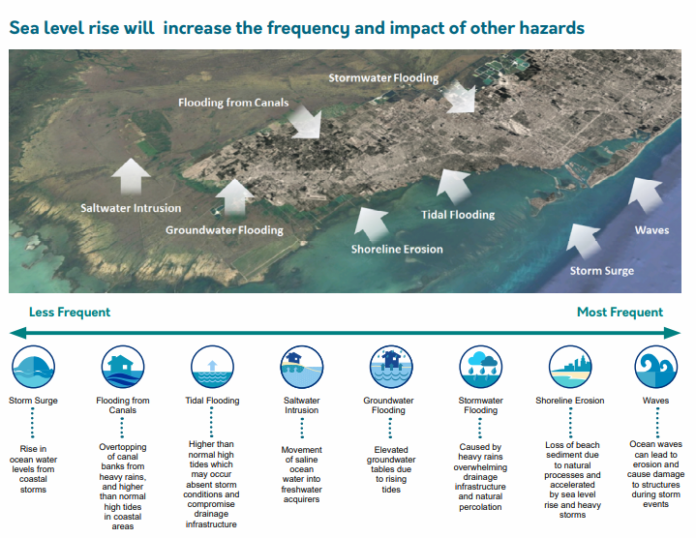Today Miami experiences sunny day flooding periodically. Places where flooding occurred once or twice a year now see 12 or more inundations annually. By 2060, without a comprehensive strategy, this area of South Florida will face continuous inundations based on climate change forecasts and a sea-level rise approaching 0.6 meters (two feet). Because of the threat, Miami-Dade County with the cities of Miami and Miami Beach very much in the crosshairs of sea-level rise has published a plan to stave off the North Atlantic.
Five adaptation strategies are to be deployed:
- Using fill to raise land levels.
- Elevating structures on stilts where inundations are most likely to be recurrent.
- Promoting development only in areas that are least flood-prone.
- Expanding waterfront parks and expand the canal system into flood-prone neighbourhoods.
- Creating places in backyards, streets, and parks for floodwater to go.
So Miami-Dade plans to adapt to the changing climate since, on its own, this part of South Florida cannot turn back the ocean through mitigation. A multi-year $20 billion investment in capital projects and programs it is hoped will make the city resilient to the rising ocean. If no investment is made, a World Bank study that looked at a 0.4-meter rise (16 inches) over the next few decades would cost the region $25 billion per year. That’s why an investment of $1 now in mitigation will save $7 in the future.
Ten immediate actions include:
- Accelerating adaptation action areas across the entire county.
- Designing all current and future projects to address sea-level rise risk.
- Developing new building and seawall elevation standards.
- Avoiding any development that could contribute to flooding of neighbouring properties.
- Expanding floodplain, parks, and canals to enhance protection from inundations.
- Flood-proofing vulnerable and critical public facilities.
- Integrating green infrastructure into present and future projects.
- Preparing disaster recovery plans and execution that focus on adaptation and mitigation.
- Addressing vulnerable septic systems.
- Creating high-ground neighbourhoods connected by elevated transit corridors.
A large number of projects are already being implemented including the building of artificial reefs and breakwaters, raising of seawalls, greening shorelines with mangroves and preserving and expanding wetlands, getting rid of concrete and asphalt surfaces to increase the permeability of land, restoring beaches and dunes, and improving stormwater infrastructure.
There are holes in this plan. One of them is the public health issue related to the proliferation of vector-borne diseases like Dengue, Chikungunya, Zika, West Nile, and Malaria with the expansion of wetlands, canals, and stormwater containment. The mosquitoes responsible for the spreading of these diseases will find in the Miami plan ideal breeding grounds for disease spread with a number of these insect species capable of breeding not just in standing water, but brackish and saltwater as well.
Another hole is the passing reference to groundwater. Even when mentioned in this report, it largely addresses underground water table levels impacting stormwater runoff capacity. Rather than making this one of the top ten challenges, the report buries the issue of freshwater availability until page 118.
Why is this an oversight? Miami-Dade County sits on top of highly porous underground geology which I have written about here in the past. This geology is subject to seawater intrusion from the ocean. As sea levels rise, the separation of fresh and saltwater in the aquifer is also on the rise. It is anticipated within two decades, that there may be little to no fresh water in the aquifer beneath the city and county. Even now, Miami-Dade is drawing water from inland well fields a considerable distance from the city. These wells are less subject to intrusion for the moment. In the end, the ultimate answer will likely be billions spent on large-scale desalination of ocean water.
It should be noted that Broward County to the immediate north of Miami-Dade, and the home to the city of Fort Lauderdale, faces the same challenges and has issued its own plan to address sea-level rise. It, too, describes similar kinds of mitigation and adaptation strategies for which my wife and I have first-hand knowledge having visited this part of South Florida a half-decade ago. At the time it was clear to me that Broward was implementing half measures with no sense of urgency. Maybe that has now changed.
In April 2020, Richard Luscombe wrote a piece for The Guardian with the following headline, “Will Florida be lost forever to the climate crisis?” It is worth the read. In it, Luscombe notes that it took 31 years for the sea level to rise 0.15 meters (6 inches) in Miami. The next 0.15 meters will take only 15 years, and the next 0.15 meters after that, 15 more. That means Miami Beach could disappear in thirty years. The political will of the former Republican Governor of the state to address climate change was lacking. The current Republican Governor is slowly beginning to fund mitigation and adaptation projects. The clock on Florida’s survival as we know it is running out.








